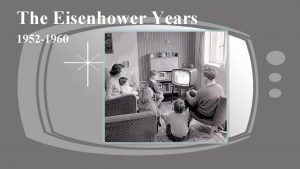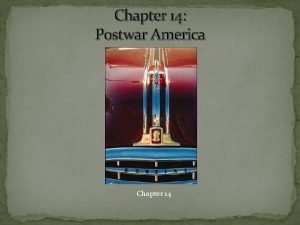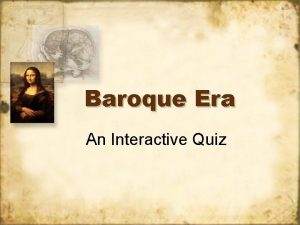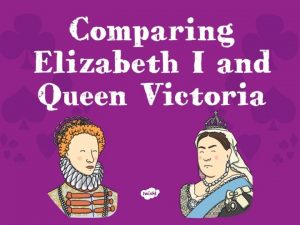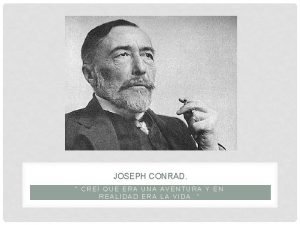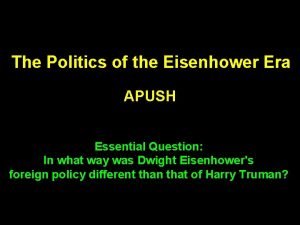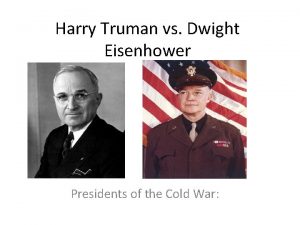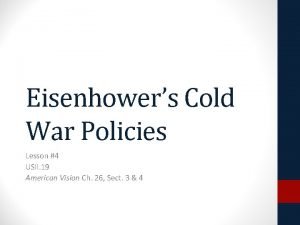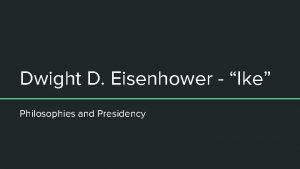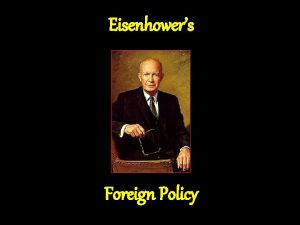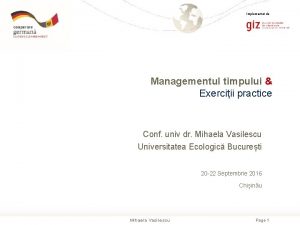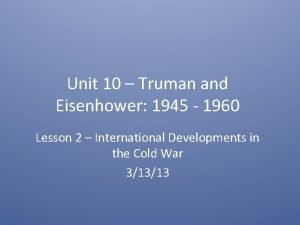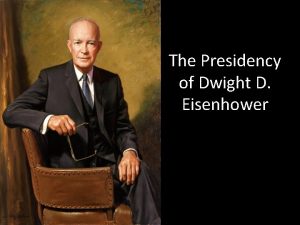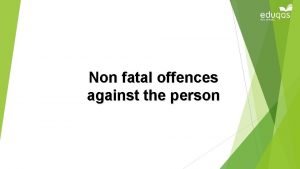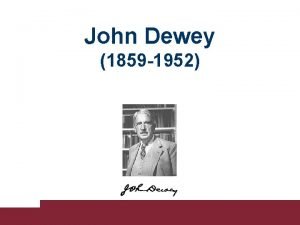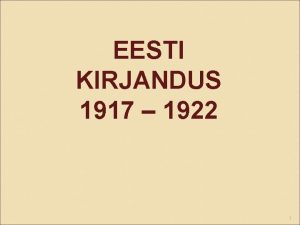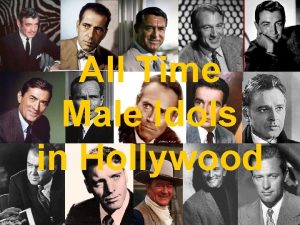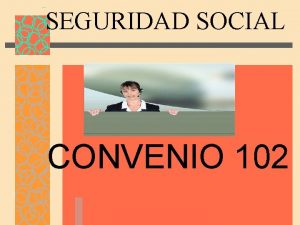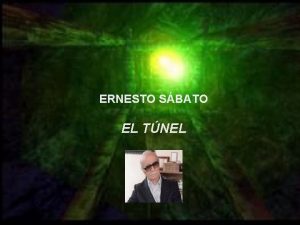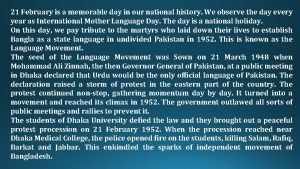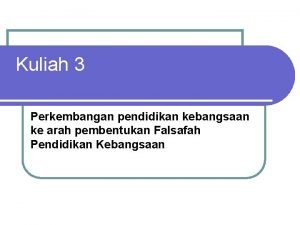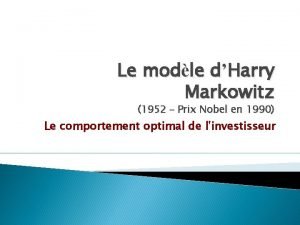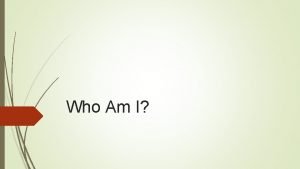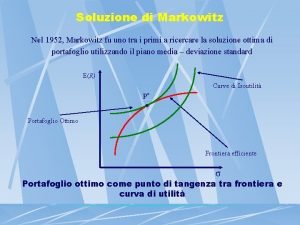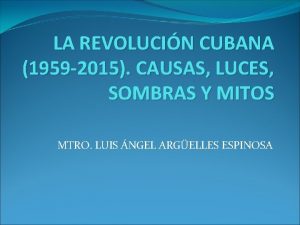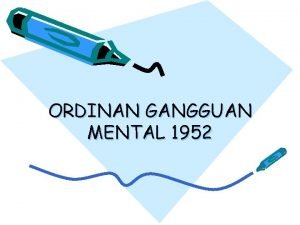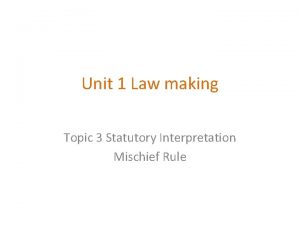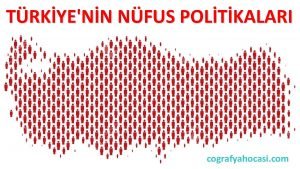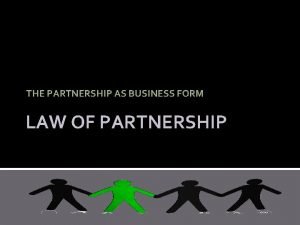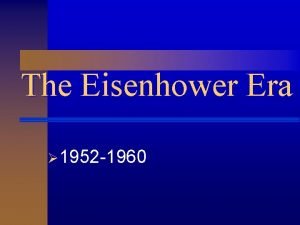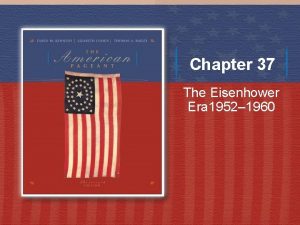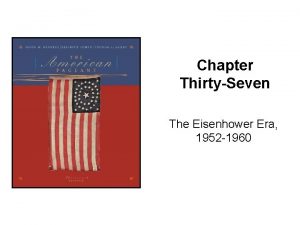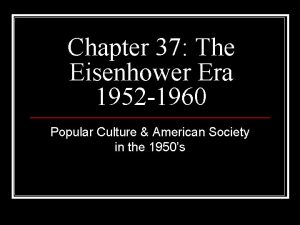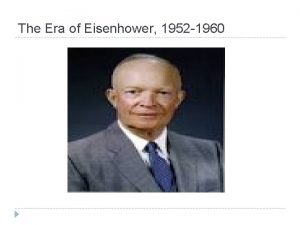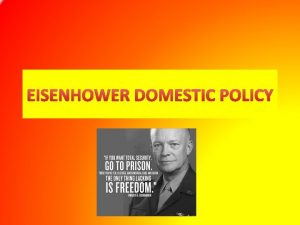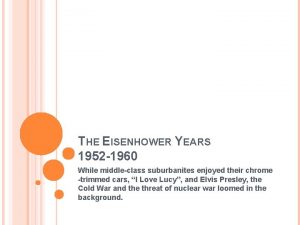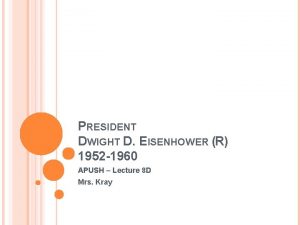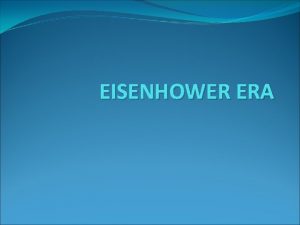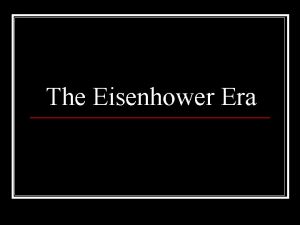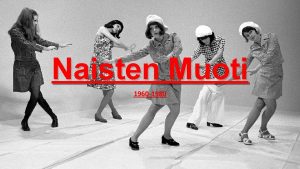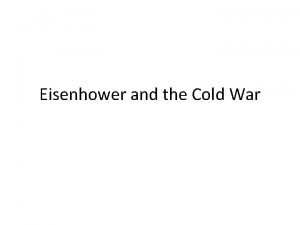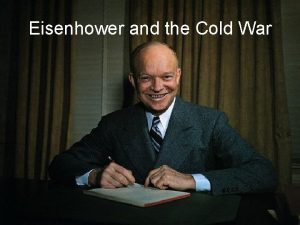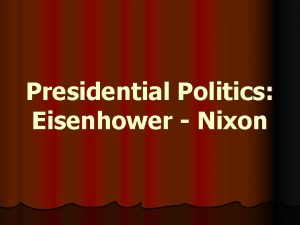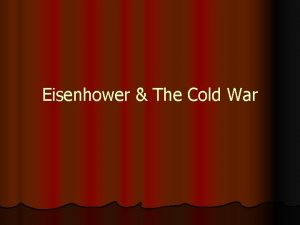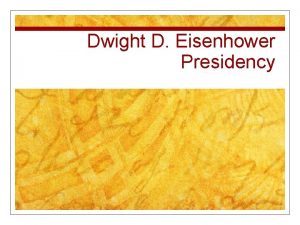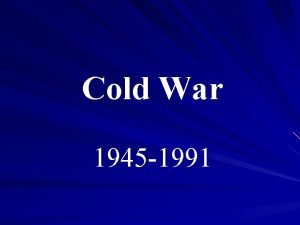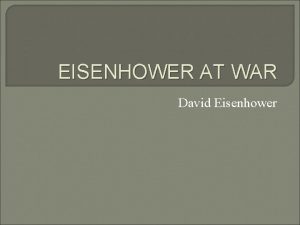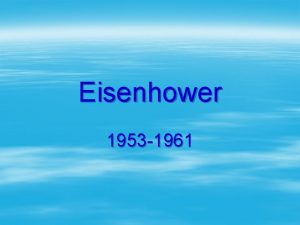Chapter 37 The Eisenhower Era 1952 1960 I
























































































- Slides: 88

Chapter 37 The Eisenhower Era, 1952– 1960

I. Affluence and Its Anxieties • Prosperity boom – Housing: • A fabulous surge in home construction • One of every four homes were built in the 1950 s • 83 percent of those new houses were in suburbia – Science and technology: • Invention of transistor in 1948 sparked a revolution in electronics, especially in computers • The first electronic computers were massive machines • Computer giant International Business Machine (IBM) prototype of the “high-tech” corporation

I. Affluence and Its Anxieties (cont. ) • The coming “information age” • Computers transformed business practices – Aerospace industries: • Connection between military and civilian aircraft production • The Seattle-based Boeing Company (1957)—the first large passenger jet, the “ 707” • First presidential jet (Eisenhower) “Air Force One” – Nature of the work force was changing: • “White collar” workers outnumbered “blue collar” • Passage from an industrial to a postindustrial or service-based economy

I. Affluence and Its Anxieties (cont. ) • Union membership peaked about 35 percent in 1954 and then steady decline (see p. 769) – Women and industry: • Surge in white-collar employment opened special opportunities for women (see Table 37. 1) • A “cult of domesticity” emerged in popular culture to celebrate those eternal feminine functions • 40 million new jobs were created from 1950 -1980 • 30 million jobs in clerical and service work • “Pink-collar ghetto” were occupations that were dominated by women (see Figure 37. 1)

I. Affluence and Its Anxieties (cont. ) • Urban age and women: • Women’s new dual role: both workers and homemakers raised urgent questions: – About family, – And traditional definitions of gender differences. • Feminist Betty Friedan: – The Feminine Mystique (1963): a classic of feminist protest literature that launched the modern women’s movement.

Table 37 -1 p 861

Figure 37 -1 p 862

II. Consumer Culture in the Fifties – 1950 s expansion of the middle class and blossoming of a consumer culture: • Dinner’s Club introduced the plastic credit card (1949) • 1948 first “fast-food” style Mc. Donald’s opened in San Bernardino, California • 1955 Disneyland opened in Anaheim, California • Manufacturers, retailers, and advertisers spread American-style consumer capitalism to rest of the world. • Especially critical was the development of the television (see Figure 37. 2)

II. Consumer Culture in the Fifties (cont. ) • Attendance at movies sank: – Entertainment industry changed from silver screen to the picture tube – $10 billion was spent on advertising on television in mid-50 s – Critics fumed that the popular new mass medium was degrading the public’s aesthetic, social, moral, political, and educational standards • Religion: – Capitalized on the powerful new electronic pulpit – Billy Graham, Oral Roberts, Fulton J. Sheen took to the airwaves to spread the Christian gospel • Catalyzed the commercialization of sports – Once numbered in the stadium-capacity thousands; could now be counted in the couch-potato millions

II. Consumer Culture in the Fifties (cont. ) – Sports reflected the shift in population toward the West and South – Creating the westward and southward sports franchises – Led to expansion of major baseball leagues, football and basketball leagues followed • Popular music dramatically transformed in the 50 s: – Chief revolutionary was Elvis Presley: » He fused black rhythm and blues with white bluegrass and country styles » Creating rock ‘n’ roll. • Marilyn Monroe helped to popularize and commercialize new standards of sensuous sexuality, as did Playboy magazine

II. Consumer Culture in the Fifties (cont. ) – As the 1950 s closed: • Americans were on their way to becoming freespending consumers of mass-produced, standardized products • Critics lamented the implications of this new consumerist lifestyle: – David Riesman, The Lonely Crowd, portrayed the postwar generation as a pack of conformists – As did William H. Whyte, The Organization Man – Similar theme in The Man in the Gray Flannel Suit (1955) by Sloan Wilson – John Kenneth Galbraith questioned the relation between private wealth and public goods in The Affluent Society (1958)

p 863

Figure 37 -2 p 863

III. The Advent of Eisenhower • Election of 1952: – Democrats • Nominated a reluctant Adlai E. Stevenson – Republicans • Enthusiastically chose war hero General Dwight D. Eisenhower on the first ballot • “Ike’s” running mate was Richard M. Nixon, who gained notoriety as the red-hunter • Nixon was the campaigner with the bare-knuckle style of political combat.

III. The Advent of Eisenhower (cont. ) – Politics and television: • Nixon, accused of taking illegal donations, appealed in a speech denying such on television—the Checkers Speech – Television was now a formidable political tool – Later Eisenhower used it in short, tightly scripted televised “spots” – These foreshadowed the future of political advertising • Television used for political purposes: – Vastly oversimplified complicated economic and social issues – Eventually turned to the standards of show business and commercialism

III. The Advent of Eisenhower (cont. ) – Results of the 1952 presidential election: • Eisenhower pledged to go personally to Korea to end the war if elected: – 33, 936, 234 votes to Stevenson’s 27, 314, 992 – 442 electoral votes to 89 (see Map 37. 1) – Ike was able to bring in Republicans to gain GOP control of the new Congress. • Eisenhower’s presidential term: – He fulfilled his pledge and went for a three day visit to Korea • It took him, after threats of atomic weapons, seven months to sign a treaty.

III. The Advent of Eisenhower (cont. ) – Korean situation: Last three years 54, 000 Americans lay dead Perhaps a million Chinese More than a million North Koreans and South Koreans were dead • Tens of billions American dollars had been poured in • The war bought only a return to the conditions of 1950 • Korea remained divided at the thirty-eighth parallel. • •

III. The Advent of Eisenhower (cont. ) • Eisenhower himself – Military commander: • A leadership style that self-consciously projected an image of sincerity, fairness, and optimism • In World War II known as an “unmilitary” general – President: • Struck the pose of an “unpolitical” president • Serenely above the petty partisan fray • His greatest “asset” was his enjoyment of the “affection and respect of our citizenry” – Critics charged he hoarded the “asset” of his immense popularity, rather then spend it for a good cause.

Map 37 -1 p 865

p 865

IV. The Rise and Fall of Joseph Mc. Carthy • First problem for Eisenhower was Mc. Carthy – Joseph R. Mc. Carthy was an obstreperous anticommunist crusader: • In February 1950, he accused Secretary of State Dean Acheson of knowingly employing 205 Communists • His rhetoric grew bolder and so did his accusations after the 1952 election • He saw the red hand of Moscow everywhere • Mc. Carthyism flourished in the seething Cold War atmosphere of suspicion and fear.

IV. The Rise and Fall of Joseph Mc. Carthy (cont. ) • He was the most ruthless and did the most damage to American traditions of fair play and free speech • Careers of countless officials, writers, and actors were ruined by “Low-Blow Joe” • Eisenhower privately loathed Mc. Carthy but publicly tried to stay out of his way • Eisenhower allowed him to control personnel policy in the State Department – Which resulted in severe damage to the morale and effectiveness of the professional foreign service – It deprived the government of a number of specialists – Damaged America’s international reputation for fair and open democracy when it was necessary.

IV. The Rise and Fall of Joseph Mc. Carthy (cont. ) – He bent too far when he attacked the U. S. army • The embattled military men fought back in 35 days of televised hearings in the spring of 1954 • Army-Mc. Carthy hearings: – Showed the political power of the new broadcast medium – Up to 20 million watched the hearings – Mc. Carthy publicly cut his own throat by parading his essential meanness and irresponsibility • The Senate formally condemned him for “conduct unbecoming a member” • Three years later Mc. Carthy died of chronic alcoholism • “Mc. Carthyism” a label for the dangerous forces of unfairness/fear, unleashed by a democracy society

V. Desegregating American Society • America’s black community in 1950 s – African Americans: • 15 million citizens in 1950 • Two-thirds of whom made their homes in the South • Jim Crow laws: – A rigid set of laws which governed all aspects of their existence – Dealing with a bizarre array of separate social arrangements » That kept them insulated from whites, economically inferior, and politically powerless » Had to have everything separated » Only about 20% eligible to vote

V. Desegregating American Society (cont. ) – Where the law proved insufficient to enforce this regime, vigilante violence did the job: » Six black war veterans, claiming the rights for which they had fought overseas, were murdered in the summer of 1946 » A Mississippi mob lynched black fourteen-year-old Emmett Till in 1955 for allegedly leering at a white woman – Segregation tarnished America’s international image • African American entertainers Paul Robeson and Josephine Baker toured the world recounting the horrors of Jim Crow

V. Desegregating American Society (cont. ) • Gunnar Myrdal book: An American Dilemma exposing the scandalous contradiction between » “The American Creed”—allegiance to the values of “progress, liberty, equality, and humanitarianism” » And the nation’s shameful treatment of black citizens. – International pressure with grassroots and legal activism • Propelled some racial progress in the North after World War II • They fought for and won equal access to public accommodations • Jackie Robinson cracked baseball’s color barrier when the Brooklyn Dodgers signed him in 1947

V. Desegregating American Society (cont. )for the Advancement of – The National Association Colored People (NAACP): • Pushed the Supreme Court in 1950 to rule in Sweatt v. Painter that separate professional schools for blacks failed to meet the test of equality – Black suffering still continued, especially in the South: • Increasingly African Americans refused to suffer in silence (see pp. 870 -871) • On December 1955 Rosa Parks made history in Montgomery, Alabama, when she boarded a bus and took a seat in the “whites only” section and refused to give it up

V. Desegregating American Society (cont. ) » Her arrest for violating the city’s Jim Crow statutes sparked a year-long black boycott of city buses » And served notice throughout the South that blacks would no longer submit meekly to the absurdities and indignities of segregation. – The Montgomery bus boycott: • The Reverend Martin Luther King, Jr. : – Unlikely champion of the downtrodden and disfranchised – He had been sheltered from the grossest cruelties of segregation – But his oratorical skill, his passionate devotion to biblical and constitutional conceptions of justice, and his devotion to nonviolent principles of India’s Mohandas Gandhi were destined to push him to the forefront of black revolution.

VI. Seeds of the Civil Rights Revolution • President Truman and blacks – Commissioned a report called “To Secure These Rights”: • He ended segregation in the federal civil service in 1948 • Ordered “equality of treatment and opportunity” in the armed forces – Congress resisted passing civil rights legislation – Truman’s successor, Eisenhower, showed no interest in racial issues.

VI. Seeds of the Civil Rights Revolution (cont. ) • Supreme Court and civil rights: – The court assumed political leadership in the civil rights struggle – Chief Justice Earl Warren: • Active judicial intervention in previously taboo social issues • Courageously led the Court to address urgent issues that Congress and the President preferred to avoid • Brown v. Board of Education of Topeka, Kansas: – Segregation in the public schools was “inherently unequal” and thus unconstitutional.

VI. Seeds of the Civil Rights Revolution (cont. ) – It reversed the Court’s rule of 1896 in Plessy v. Ferguson (see p. 496) that “separate but equal” facilities were allowable under the Constitution • Desegregation must go ahead with “all deliberate speed” – Border States made reasonable efforts to comply – Deep South organized “massive resistance” – Southern congressional members signed the “Declaration of Constitutional Principles” in 1956 » Pledging their unyielding resistance to desegregation – Some states diverted public funds to start private schools – Ten years later only 2% of the eligible blacks in the Deep South were sitting in classrooms with whites.

VI. Seeds of the Civil Rights Revolution (cont. ) • President Eisenhower remained reluctant to promote integration – Wanted to educate white Americans about the need for racial justice – Felt that the recent Court’s ruling upset “the customs and convictions of at least two generations of Americans” – He steadily refused to issue a public statement endorsing the Court’s conclusion.

VI. Seeds of the Civil Rights Revolution (cont. ) – In September, Ike was forced to act: • Orval Faubus, governor of Arkansas, mobilized the National Guard to prevent 9 black students from enrolling in Little Rock’s Central High School » Ike sent troops to escort the children to their classes – Congress passed the first Civil Rights Act since Reconstruction • It set up a permanent Civil Rights Commission to investigate violations of civil rights • And authorized federal injunctions to protect voting rights.

VI. Seeds of the Civil Rights Revolution (cont. ) • Blacks and civil rights movement: – Martin Luther King, Jr. formed the Southern Christian Leadership Conference (SCLC) in 1957 • Aimed to mobilize the vast power of black churches on behalf of black rights • Churches were the largest and best-organized black institutions – Black “sit-in” movement launched February 1, 1960 • By four black college freshmen in Greensboro, NC • They demanded service at a whites-only Woolworth’s lunch counter

VI. Seeds of the Civil Rights Revolution (cont. ) • Sit-ins swelled into wade-ins, lie-ins, and pray-ins to compel equal treatment • April, 1960 southern black students formed the Student Nonviolent Coordinating Committee (SNCC): – Pronounced “snick” – To give more focus and force to these efforts – Young and impassioned, SNCC members would: » Lose patience with the more stately tactics of the SCLC » And the even more deliberate legalism of the NAACP.

p 869

p 872

VII. Eisenhower Republicanism at Home • Eisenhower in 1953 – Administration of “dynamic conservatism” • Dealing with people: “Be liberal, be human” • “People’s money, or their economy, or their form of government, be conservative” • A balanced, middle-of-the-road course • Strove to balance the federal budget: – Guard the Republic from what he called “creeping socialism” – Supported the transfer of control over offshore oil fields from the federal government to the states

VII. Eisenhower Republicanism at Home (cont. ) – Tried to curb the TVA (see p. 766) by encouraging a private power company to build a generating plant to compete with the massive public utility – Eisenhower’s secretary of health, education, and welfare condemned the free distribution of the Salk antipolio vaccine as “socialized medicine” • Eisenhower responded to the Mexican government concern about illegal Mexican immigrants (see p. 803) – Operation Wetback— 1 million Mexicans were apprehended and returned to Mexico in 1954 • Eisenhower sought to cancel the tribal preservation policies of the “Indian New Deal” (see p. 765)

VII. Eisenhower Republicanism at Home (cont. ) – He proposed to “terminate” the tribes as legal entities – And to revert to the assimilationist goals of the Dawes Severalty Act of 1887 (see p. 581) – Most Indians resisted termination, and the policy was abandoned in 1961 • Ike backed the Federal Highway Act of 1956: – a $27 billion plant to build forty-two thousand miles of sleek, fast motorways – Essential to the national defense – Created countless construction jobs – Sped the suburbanization of America – The Highway Act offered juicy benefits to the trucking, automobile, oil, and travel industries – While robbing the railroads, especially passenger trains, of business

VII. Eisenhower Republicanism at Home (cont. ) – The act exacerbated problems of air quality and energy consumption – Had disastrous consequences for cities.

p 872

VIII. A “New Look” in Foreign Policy • 1952 Republican platform called for a “new look” at foreign policy – Condemned “containment” – John Foster Dulles, secretary of state: • Wanted to “roll back” gains of the red tides and “liberate captive peoples” • Same time promised to balance the budget by cutting military spending • Dulles announced a policy of boldness 1954: – Eisenhower would relegate the army and navy to the backseat and build up an airfleet of superbombers (called the Strategic Air Command, SAC)

VIII. A “New Look” in Foreign Policy (cont. ) – They would be equipped with city-flattening weapons » Inflict “massive retaliation” on the enemies » Advantage: paralyzing nuclear impact and cheaper price tag – Sought a thaw in the Cold War: • Through negotiations with the new Social leaders • In the end the “new look” proved illusory • Nikita Khrushchev, Soviet leader, rejected Ike’s call for an “open skies” mutual inspection program • U. S. refused aid to the Hungarians in their 1956 uprising • The Hungarian uprising revealed America’s nuclear weapon was ineffective in relatively minor crisis

VII. A “New Look” in Foreign Policy (cont. ) • The “massive retaliation” doctrine: – Was starkly exposed – Eisenhower discovered that the aerial and atomic hardware necessary for “massive retaliation” was staggeringly expensive.

IX. The Vietnam Nightmare • Vietnam and Ho Chi Minh: – Nationalist movement sought to throw off the French colonial rule – Minh appealed to Wilson for self-determination – Cold War events damped anticolonial Asian people’s dreams: • Their leaders became increasingly communists while the United States became increasingly anticommunists • 1954 America was paying 80% of the costs in Indochina • It amounted to about $1 billion

IX. The Vietnam Nightmare (cont. ) • French continued to crumble under Ho Chin Minh’s nationalist guerrilla forces—called Viet Minh • French garrison was trapped in fortress of Dien Bien Phu • The new “policy of boldness” was now to be tested • Some favored intervention with American bombers • Eisenhower, correctly fearing British nonsupport, held back. – The Battle of Dien Bien Phu: • Proved a victory for the nationalists • A multination conference in Geneva halved Vietnam at the seventeenth parallel (see Map 37. 2)

IX. The Vietnam Nightmare (cont. ) • Ho Chi Minh in the north consented to the arrangement on the assurance Vietnam-wide elections would be held within two years • South: a pro Western government under Ngo Dinh Diem was entrenched at Saigon • The Vietnamese never held the promised elections • Eisenhower promised economic and military aid to the autocratic Diem regime, for social reforms • The Americans had evidently backed a losing horse but could see no easy way to call off their bet.

37 -2 p 875

X. Cold War Crises in Europe and the Middle East • Postwar Germany: • The Germans were welcomed into NATO 1955 • With an expected contribution of half a million troops • Eastern Europe countries and the Soviets created the Warsaw Pact to the newly NATO forces – The Cold War was thawing a bit in 1955: • Soviets agreed to end their occupation of Austria • Summer conference in Geneva produced little • Hope increased when Soviet Communist boss Khrushchev publicly denounced Stalin’s bloody excesses

X. Cold War Crises in Europe and the Middle East (cont. ) – Violent events in 1956 ended the post-Geneva lull: • Hungarian revolt was overpowered by Soviet tanks • Fear that the Soviets would penetrate the oil-rich Middle East • The government of Iran resisted the Western powers • The American Central Intelligence Agency (CIA) helped engineer a coup in 1953 that installed Mohammed Reza Pahlevi • The American intervention left a bitter legacy of resentment among the Iranians • Two years later they took revenge on the shah and his American allies (see pp. 936 -938).

X. Cold War Crises in Europe and the Middle East (cont. ) • The Suez crisis: – President Nasser of Egypt was seeking funds to build a dam on the upper Nile: • America and Britain tentatively offered financial help • When Nasser began to deal with the communists, Secretary of State Dulles withdrew the dam offer – Nasser regained face by nationalizing the Suez Canal, owned chiefly by British and French stockholders – Britain and France, with help from Israel, staged an assault on Egypt late October 1956 thinking that they would get help from the United States – A furious Eisenhower refused to release emergency oil supplies.

X. Cold War Crises in Europe and the Middle East (cont. ) • The Suez crisis was the last time the United States could use their “oil weapon. ” – 1940 U. S. produced two-thirds of the world’s oil, with 5% coming from the Middle East – By 1948 the U. S. had become a major importer. • The Eisenhower Doctrine (1957): – Pledging military and economic aid to Middle Eastern nations threatened by communists – The real threat was not communism, but nationalism

X. Cold War Crises in Europe and the Middle East (cont. ) – Nationalists attempted to rid themselves of Western companies pumping out their oil – In 1960 the Organization of Petroleum Exporting Countries (OPEC) was formed: • Member nations: Saudi Arabia, Kuwait, Iraq, Iran, joined with Venezuela • Within two decade, OPEC’s stranglehold on the Western economic would tighten.

XI. Round Two for Ike • Election of 1956: – President Eisenhower was pitted against Adlai Stevenson • Hard for Democrats to find issues to use against Ike • Voters still liked Ike • Election returns: – – – 35, 590, 472 for Eisenhower; 26, 022, 752 for Stevenson Electoral College count 457 for Republicans, 73 Democrats Eisenhower made deep roads into the once-solid South Louisiana went Republican; first time since 1876 Eisenhower failed to win either house of Congress The first time since Zachary Taylor in 1848.

IX. Round Two for Ike (cont. ) • His administration: – First half part-time president; rallied the last few years. • Labor legislation: – – – American unions fraud and other tactics: AF L-CIO expelled James R. “Jimmy” Hoffa » Convicted of jury tampering, served part of his sentence before disappearing without a trace Eisenhower persuaded Congress to pass Landrum-Griffin Act (1959): » Designed to bring labor leaders to book for financial shenanigans and bullying tactics » It expanded some antilabor strictures of the earlier Taft-Hartley Act (see p. 830).

IX. Round Two for Ike (cont. ) • Soviet launched Sputnik I and Sputnik II into space • “Rocket fever” swept the nation: – Eisenhower created the National Aeronautics and Space Administration (NASA) – Vanguard blew up on national television – By the end of the decade, several satellites had been launched and the U. S. successfully tested its own ICBMs – Sputnik spurred changes in the educational system – Late 1958 the National Defense and Education Act (NDEA) authorized $887 million in loans to needy college students – Grants for the improvement of teaching the sciences and languages.

p 877

XII. The Continuing Cold War – 1958 under the Eisenhower Doctrine: • Several thousand troops were sent to Lebanon • Eisenhower invited Khrushchev to Washington 1959 – Khrushchev at the UN resurrected the ancient Soviet proposal of complete disarmament – Khrushchev met with Eisenhower at Camp David » He said that his ultimatum for the evacuation of Berlin would be extended indefinitely – By the Paris “summit conference” Moscow and Washington had each taken a firm stand on the burning Berlin issue – On the eve of the conference an American U-2 plane was shot down deep into Russia – “Honest Ike” took full personal responsibility – This ended the Paris conference.

XIII. Cuba’s Castroism Spells Communism • Uncle Sam and Latin America: – Latin Americans bitterly resented the meager millions in aid – Chafed America for its continuing habit of intervening in Latin American affairs – Washington continued to support dictators who claimed to be combating communists – Communist beachhead in Cuba: • Fulgencio Batista had encouraged huge investments of American capital, Washington gave some support • Early 1959 Fidel Castro engineered a revolution to oust Batista

XIII. Cuba’s Castroism Spells Communism (cont. ) – Castro: • Denounced the Yankee imperialists • Began to expropriate valuable American properties in pursuing a land-distribution program • Washington released Cuba from “imperialistic slavery” by cutting off the heavy U. S. imports of Cuban sugar • Castro retaliated by confiscating Yankee property and made his dictatorship an economic and military satellite of Moscow • Anti-Castro Cubans headed for the United States, especially Florida

XIII. Cuba’s Castroism Spells (cont. ) • Washington broke diplomatic relations with Cuba in 1961 • Imposed a strict embargo on trade with Cuba – The Helms-Burton Act of 1996: » The embargo has remained in place, even since Castro’s departure from power in 2008. – The Soviets set up a communist base only 90 miles from American shores.

XIV. Kennedy Challenges Nixon for the Presidency • Election of 1960 – Republicans: • The “new” Nixon was represented as a mature, seasoned statesman • He gained notice in the kitchen debate with Khrushchev in Moscow 1959 where Nixon extolled the virtues of American consumerism over Soviet economic planning • The next year he won the Republican nomination • His running mate was Henry Cabot Lodge, Jr.

XIV. Kennedy Challenges Nixon for the Presidency (cont. ) – Democrats: • John F. Kennedy won impressive victories in the primaries • He scored a first-ballot over Senator Lyndon B. Johnson, the Senate majority leader from Texas • Kennedy’s challenging acceptance speech called the New Frontier • Kennedy was the first Roman Catholic to be nominated since Al Smith in 1929 • Kennedy challenged the Catholic questions • His Catholicism aroused misgivings in the Protestant Bible Belt South, which was ordinarily Democratic

XIV. Kennedy Challenges Nixon for the Presidency (cont. ) • The religious issue largely canceled itself out • Kennedy charged that the Soviets with their Sputniks had gained on America in prestige and power. – Television may have tipped the scales: • Nixon agreed to meet Kennedy in four debates • Kennedy held his own • Kennedy did not suffer by comparison with the more “experienced” Nixon • Viewers found Kennedy far more appealing than Nixon’s tired and pallid appearance.

XIV. Kennedy Challenges Nixon on the Presidency (cont. ) • Elections results: – Kennedy— 303 electoral votes to 219 for Nixon – Kennedy’s popular vote margin only 118, 574 votes out of over 68 millions cast (see Map 37. 3) – First Roman Catholic and youngest person elected to the presidency – Kennedy ran well in industrial centers – Democrats swept both houses of Congress by wide margins.

XV. An Old General Fades Away – President Eisenhower continued to enjoy extraordinary popularity to the final curtain: • He was universally admired, respected for his dignity, decency, sincerity, goodwill and moderation • Pessimists had predicted he would be a seriously crippled “lame duck” during his second term: – By the barrier against reelection erected by the 22 th Amendment ratified in 1951 (See the Appendix) – He displayed more vigor, more political know-how, more aggressive leadership during his last two years as president than ever before.

XV. An Old General Fades Away (cont. ) – Congress 1955 to 1961 controlled by Democrats: • Eisenhower exerted unusual control over the legislative branch – Wielded the veto 169 times – Only twice was his nay overridden by the required twothirds vote. – America during his terms as President: • Was fabulously prosperous • The vast St. Lawrence waterway was completed 1959 • “Old Glory” could now proudly display 50 states – Alaska and Hawaii attained statehood 1959.

XV. An Old General Fades Away (cont. ) – Eisenhower mounted no moral crusade for civil rights • This perhaps was his greatest failure • As Republican president: – He had further woven the reforms of the Democratic New Deal and Fair Deal into the fabric of national life – Exercised wise restraint in his use of military power – Soberly guided foreign policy away from countless threats to peace – He left office crestfallen at his failure to end the arms race with the Soviets – As the decades lengthened, appreciation of him grew.

Map 37 -3 p 880

XVI. A Cultural Renaissance • U. S. power in post-World War II decades were matched by international ascendancy in the arts – Art: • Americans supported countless painters, sculptors • Using the open and tradition-free American environment became the experimental mood • Jackson Pollock pioneered abstract expressionism – Pollock and Willem de Kooning created spontaneous “action paintings” that expressed the painter’s individuality and made the viewer a participant – Mark Rothko and his fellow “color field” painters enveloped whole canvases with bold, shimmering swaths of color

XVI. A Cultural Renaissance (cont. ) • “Pop” (short for popular) artists: – Andy Warhol canonized on canvas mundane items of consumer culture – Roy Lichtenstein parodied old-fashioned comic strips – Claes Oldenburg made exotic versions of everyday objects – Architecture: • Residential building boom erected look-alike, rangestyle houses across suburban landscape • Ultra-modern skyscrapers arose in the nation’s urban centers • “International Style”—modernist, massive corporate high-rises were essentially giant steel boxes wrapped in glass

XVI. A Cultural Renaissance (cont. ) • Examples of these “curtain-wall” designs: United Nations headquarters (1952), the Seagram Building (1957), the Sears Tower (1974), and the John Hancock Tower (1976) • Frank Lloyd Wright produced original designs: the round-walled Guggenheim Museum (1959) • Louis Kahn employed plain geometric forms and basic building materials—bricks, concrete, Salk Institute • Eero Saarinen, Finnish immigrant, TWA Flight Center (1962), Gateway Arch (1965) • I. M. Pei, East Wing of the National Gallery of Art (1978), John F. Kennedy Library (1979).

XVI. A Cultural Renaissance (cont. ) – Literature: • Ernest Hemingway, The Old Man and the Sea (1952) • John Steinbeck, East of Eden (1952), Travels with Charley (1962) for which he received the Nobel Prize for literature in 1962, the seventh American to be honored • World War II literature—searing realism: – Norman Mailer, The Naked and the Dead (1948) – James Jones, From Here to Eternity (1956) – World War II literature—war in fantastic and psychedelic prose

XVI. A Cultural Renaissance (cont. ) • Joseph Heller, Catch-22 dealt with improbable antics and anguish of American airmen in the wartime Mediterranean (1961) • Kurt Vonnegut, Jr. , Slaughterhouse Five, the dark comedy war tale (1969) • Counterculture “Beat” writers rejected modern American life outright, seeking romantic selfexpression in stridently nonconformist lifestyles (see pp. 884 -885) • John Updike: – Rabbit, Run celebrated the feats and failings of ordinary small-town America in sensual detail (1960)

XVI. A Cultural Renaissance (cont. ) – Couples explicitly addressed suburban, middle-class infidelity (1968) • John Cheever, The Wapshot Chronicle (1957) chronicled suburban manners and morals in short stories • Gore Vidal: Myra Breckinridge (1968), he wrote some intriguing historical novels. – Poets: • Were highly critical, even deeply despairing about the conformist character of midcentury America • Experimented with a frank “confessional” style, revealing personal experiences with sex, drugs, and madness.

XVI. A Cultural Renaissance (cont. ) • Robert Lowell: – Life Studies (1959) helped inaugurate this trend with his psychologically intense story – For the Union Dead (1964) sought to apply the wisdom of the Puritan past to the perplexing present in allegorical poems • Sylvia Plath: – Ariel (published posthumously in 1966) – The Bell Jar (1963) is a disturbing autobiographical novel • Anne Sexton: To Bedlam and Part Way Back (1960) brooding autobiographical poems – Writing poetry seemed to be a dangerous pursuit in modern America – The life of the poet began in sadness and ended in madness.

XVI. A Cultural Renaissance (cont. ) – Playwrights: • Were acute observers of postwar American social mores • Tennessee Williams – Wrote a series of blistering dramas about psychological misfits struggling to hold themselves together amid the disintegrating forces of modern life – Noteworthy: A Streetcar Named Desire (1947) and Cat on a Hot Tin Roof (1955) each delivered powerful critiques of the contemporary restrictions placed on women’s lives • Arthur Miller – Brought to the stage searching probes of American values

XVI. A Cultural Renaissance (cont. ) – Death of a Salesman (1949), a tragic indictment of the American drama of material success – The Crucible (1953), which treated the Salem witch trials as a dark parable warning against the dangers of Mc. Carthyism • Lorraine Hansberry, A Raisin in the Sun (1959) offered an affecting, realistic portrait of African American life • Edward Albee, Who’s Afraid of Virginia Woolf? (1962) exposed the rapacious underside of middle-class life – Novelists: • The novel was the preferred genre for chroniclers of the postwar literary scene • A number of authors set out to produce “the great American novel”

XVI. A Cultural Renaissance (cont. ) • Mark Twain’s Adventures of Huckleberry Finn • F. Scott Fitzgerald’s Great Gatsby – These took the form of a tale chronicling the education and maturation of a young protagonist • J. D. Salinger’s The Catcher in the Rye painted an unforgettable portrait of adolescent angst, alienation, and rebellion • Ralph Ellison’s Invisible Man (1952) depicted the African American’s often tortured quest for personal identity • Saul Bellow’s The Adventures of Augie March (1953) concocted a more readily recognizable Everyman

XVI. A Cultural Renaissance (cont. ) • Harper Lee’s To Kill a Mockingbird (1960) tells of racial injustice and the loss of youthful innocence – Harlem Renaissance • Richard Wright: – Native Son (1940), chilling portrait of a black Chicago killer – Black Boy (1945), semi-autographical • James Baldwin’s The Fire Next Time, sensitive reflections on the racial question • Black nationalist Le. Roi Jones’ Dutchman (1964), changed his name to Imamu Amiri Baraka, crafted powerful plays

XVI. A Cultural Renaissance (cont. ) – Southern Renaissance: • Led by William Faulkner, a Nobel recipient in 1950 • They distanced themselves from an earlier “Lost Cause” literature that had glorified the antebellum South • Writers brought a new critical appreciation to the region’s burdens of history, racism, and conservatism • Robert Penn Warren’s All the King’s Men (1946) immortalized Louisiana politico Huey Long • Walker Percy, Eudora Welty and Flannery O’Connor: – Perceptively tracked the changes reshaping the postwar South, while also exploring universal themes of yearning, failure, success, and sorrow.

XVI. A Cultural Renaissance (cont. ) • William Styron, The Confessions of Nat Turner (1967) confronted the harsh history of his home state, Virginia, in a controversial fictional representation of an 1831 slave rebellion – Jewish novelists: • Found their favorite subject matter in the experience of lower- and middle-class Jewish immigrants • Bernard Malamud: – The Assistant (1957) rendered a touching portrait of a family of New York Jewish shopkeepers – The Natural (1952) explored the mythic qualities of the culture of baseball.

XVI. A Cultural Renaissance (cont. ) • Philip Roth: – Goodbye, Columbus (1959) written comically about young New Jersey suburbanites – Portnoy’s Complaint (1969) penned an uproarious account of a sexually obsessed middle-aged New Yorker • Saul Bellow: – Wrote masterful sketches of Jewish urban and literary life – His landmark achievements Augie March and Herzog (1962) – Won the Nobel Prize for literature in 1976, becoming the eighth American so honored in the previous half-century.

p 882

p 884

p 884

p 888
 The eisenhower years, 1952-1960
The eisenhower years, 1952-1960 Lesson 1 truman and eisenhower
Lesson 1 truman and eisenhower Quiz 2 the baroque era
Quiz 2 the baroque era Elizabethan and victorian era
Elizabethan and victorian era Creí que era una aventura y en realidad era la vida
Creí que era una aventura y en realidad era la vida Poema sobre as estrelas
Poema sobre as estrelas Open skies apush
Open skies apush Truman vs eisenhower
Truman vs eisenhower Matriz de eisenhower excel baixar
Matriz de eisenhower excel baixar Dwight d eisenhower domestic policy
Dwight d eisenhower domestic policy Lesson 4 eisenhowers cold war policies
Lesson 4 eisenhowers cold war policies Eisenhower philosophy
Eisenhower philosophy Eisenhower
Eisenhower Sclc and sncc venn diagram
Sclc and sncc venn diagram Truman foreign policy vs eisenhower
Truman foreign policy vs eisenhower Dwight d eisenhower accomplishments
Dwight d eisenhower accomplishments Eisenhower middle school everett
Eisenhower middle school everett Metoda eisenhower
Metoda eisenhower Lesson 1 truman and eisenhower
Lesson 1 truman and eisenhower Eisenhower
Eisenhower Analisi strategica per le decisioni aziendali sapienza
Analisi strategica per le decisioni aziendali sapienza Jcc v eisenhower
Jcc v eisenhower Hát kết hợp bộ gõ cơ thể
Hát kết hợp bộ gõ cơ thể Lp html
Lp html Bổ thể
Bổ thể Tỉ lệ cơ thể trẻ em
Tỉ lệ cơ thể trẻ em Gấu đi như thế nào
Gấu đi như thế nào Thang điểm glasgow
Thang điểm glasgow Hát lên người ơi
Hát lên người ơi Các môn thể thao bắt đầu bằng tiếng bóng
Các môn thể thao bắt đầu bằng tiếng bóng Thế nào là hệ số cao nhất
Thế nào là hệ số cao nhất Các châu lục và đại dương trên thế giới
Các châu lục và đại dương trên thế giới Cong thức tính động năng
Cong thức tính động năng Trời xanh đây là của chúng ta thể thơ
Trời xanh đây là của chúng ta thể thơ Cách giải mật thư tọa độ
Cách giải mật thư tọa độ Phép trừ bù
Phép trừ bù độ dài liên kết
độ dài liên kết Các châu lục và đại dương trên thế giới
Các châu lục và đại dương trên thế giới Thơ thất ngôn tứ tuyệt đường luật
Thơ thất ngôn tứ tuyệt đường luật Quá trình desamine hóa có thể tạo ra
Quá trình desamine hóa có thể tạo ra Một số thể thơ truyền thống
Một số thể thơ truyền thống Bàn tay mà dây bẩn
Bàn tay mà dây bẩn Vẽ hình chiếu vuông góc của vật thể sau
Vẽ hình chiếu vuông góc của vật thể sau Thế nào là sự mỏi cơ
Thế nào là sự mỏi cơ đặc điểm cơ thể của người tối cổ
đặc điểm cơ thể của người tối cổ V cc
V cc Vẽ hình chiếu đứng bằng cạnh của vật thể
Vẽ hình chiếu đứng bằng cạnh của vật thể Phối cảnh
Phối cảnh Thẻ vin
Thẻ vin đại từ thay thế
đại từ thay thế điện thế nghỉ
điện thế nghỉ Tư thế ngồi viết
Tư thế ngồi viết Diễn thế sinh thái là
Diễn thế sinh thái là Dạng đột biến một nhiễm là
Dạng đột biến một nhiễm là Số nguyên tố là số gì
Số nguyên tố là số gì Tư thế ngồi viết
Tư thế ngồi viết Lời thề hippocrates
Lời thề hippocrates Thiếu nhi thế giới liên hoan
Thiếu nhi thế giới liên hoan ưu thế lai là gì
ưu thế lai là gì Sự nuôi và dạy con của hươu
Sự nuôi và dạy con của hươu Khi nào hổ con có thể sống độc lập
Khi nào hổ con có thể sống độc lập Sơ đồ cơ thể người
Sơ đồ cơ thể người Từ ngữ thể hiện lòng nhân hậu
Từ ngữ thể hiện lòng nhân hậu Thế nào là mạng điện lắp đặt kiểu nổi
Thế nào là mạng điện lắp đặt kiểu nổi 21 february is observed as shaheed dibosh every year
21 february is observed as shaheed dibosh every year Mudaliar education commission
Mudaliar education commission Mario montessori alessandro montessori
Mario montessori alessandro montessori Strumentalismo dewey
Strumentalismo dewey Hrvatska književnost 1929 do 1952
Hrvatska književnost 1929 do 1952 Ekspresionizam u hrvatskoj književnosti ppt
Ekspresionizam u hrvatskoj književnosti ppt Poeet 1890 1952
Poeet 1890 1952 Ivanhoe 1952
Ivanhoe 1952 The seed of independence was sown on 21 february 1952
The seed of independence was sown on 21 february 1952 Convenio 102 norma minima de seguridad social
Convenio 102 norma minima de seguridad social Affiche plan marshall
Affiche plan marshall Jean paul 1952
Jean paul 1952 El túnel 1952
El túnel 1952 21 february
21 february Ilon vuosi 1952
Ilon vuosi 1952 Apakah tujuan ordinan pelajaran 1952 diwujudkan
Apakah tujuan ordinan pelajaran 1952 diwujudkan Oae207
Oae207 Markowitz 1952
Markowitz 1952 Max ehrmann desiderata copyright 1952
Max ehrmann desiderata copyright 1952 Markowitz 1952
Markowitz 1952 Revolucion nacional de 1952 causas
Revolucion nacional de 1952 causas Ordinan gangguan mental 1952
Ordinan gangguan mental 1952 Magor and st mellons v newport corporation
Magor and st mellons v newport corporation Türkiye nüfus artış hızı grafiği
Türkiye nüfus artış hızı grafiği Bester v van niekerk
Bester v van niekerk
